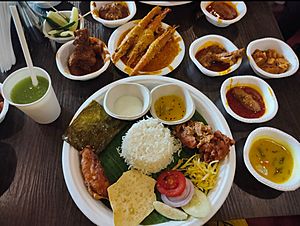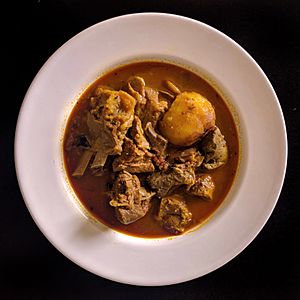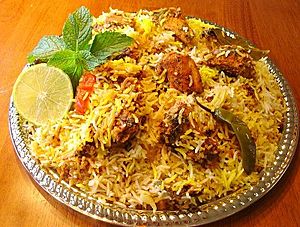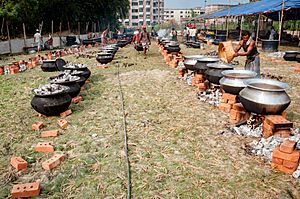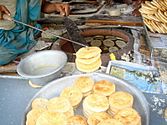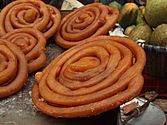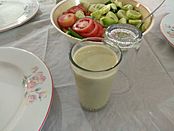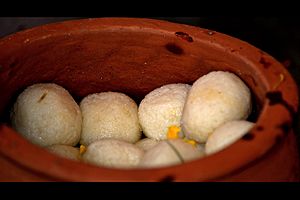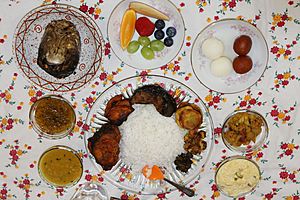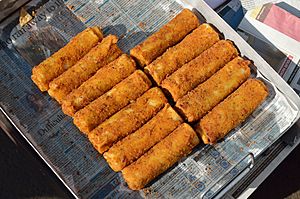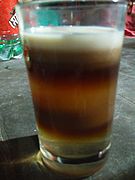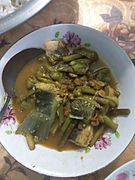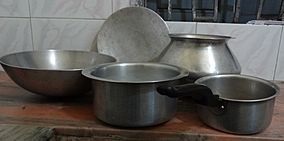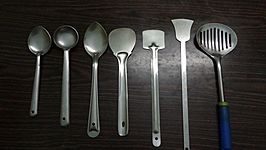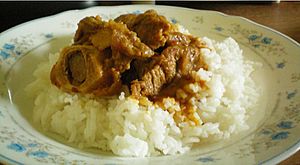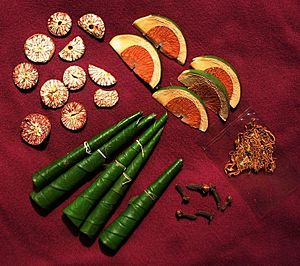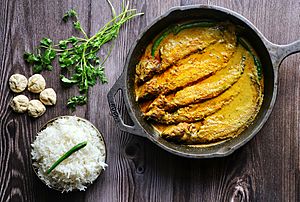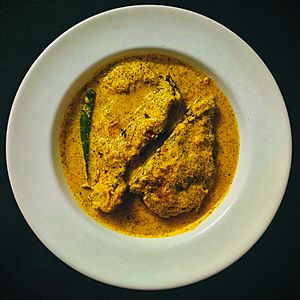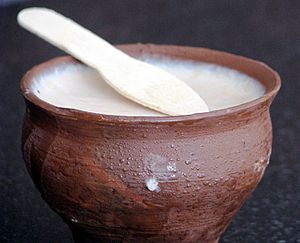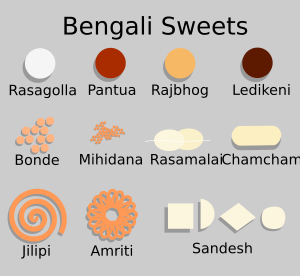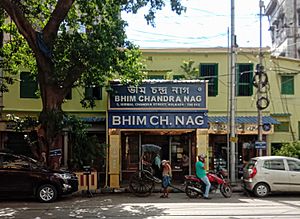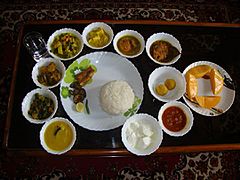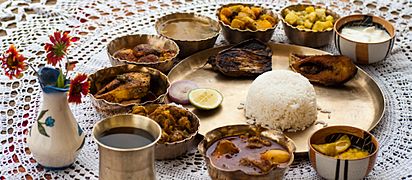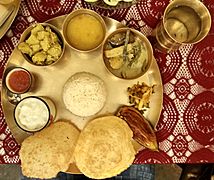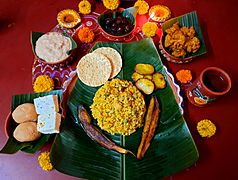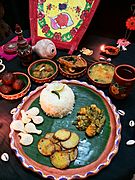Bengali cuisine facts for kids
Bengali cuisine (Bengali: বাঙ্গালী রন্ধনপ্রণালী) is the culinary style of Bengal, a region in the eastern part of the Indian subcontinent encompassing Bangladesh and the Indian states of West Bengal, Tripura and Assam's Barak Valley. The cuisine has been shaped by the region's diverse history and climate. It is known for its varied use of flavours, as well as the spread of its confectioneries and desserts. Bengali cuisine has the only traditionally developed multi-course custom in the South Asia that is analogous in structure to the modern service à la russe style of French cuisine, with food served in courses rather than all at once. There is a strong emphasis on rice as a staple, served with fish, meat, vegetables, and lentils. Many Bengali food traditions draw from social activities, such as adda, or the Mezban.
Contents
Culinary influences
Mughal influence
Muslims conquered Bengal around the mid-thirteenth century, bringing with them Persian and Arabic cuisine. Such dishes as biryani, korma and bhuna had once been meals of the higher courts, but the cooks of the Mughals brought their recipes to the lower and middle classes. The influence was reinforced during the rule of the British Raj, where Kolkata became the place of refuge for many prominent exiled Nawabs, notably the family of Tipu Sultan from Mysore and Wajid Ali Shah, the ousted Nawab of Awadh. The exiles brought with them hundreds of cooks and masalchis (spice mixers), and as their royal patronage and wealth diminished, they became interspersed into the local population. These cooks came with the knowledge of a very wide range of spices (most notably jafran and mace), the extensive use of ghee, and marinating meat with yoghurt and chilli.
In Bangladesh, this food has become common fare for the population while in West Bengal, they have remained the food of professional chefs. Further innovations include chap (ribs slow cooked on a tawa), rezala (meat in a thin yogurt and cardamom gravy) and kathi roll (kebabs in a wrap).
The Mughals had a particular fixation on meat, bringing mutton and beef into mainstream Bengali cuisine as well as already known kinds of meat like chicken and venison.
Furthermore, traditional desserts had been primarily based on rice pastes and jaggery, but under Mughal influence moved towards significantly increased use of milk, cream, and sugar along with expensive spices such as cardamom and saffron.
Influence of widows
In Hindu patriarchal tradition, widows were not allowed to eat foods that would not be classified as "bitter", necessitating experiment and innovation. While most Bengali castes ate meat and fish, this was barred for widows. Widows also could not use "heating" foods such as shallot and garlic, but ginger was allowed. This style found a core place in Bengali curries in general, both vegetarian and non-vegetarian. Expensive spices such as saffron, cinnamon or cloves were used very sparingly—if at all. Nuts, dry fruits, milk and milk products (such as cream, ghee or curd) were similarly scarce. These economic and social restrictions influenced Bengali widows to create a brand new set of meals that utilized only vegetables and cheap spices.
Partition of Bengal
The large-scale displacement along religious lines as a result of the partition led to changes in meal-taking, as to adhere to religious restrictions. In Bangladesh (former East Bengal and East Pakistan), Mughlai food is common, and includes foods that are less popular in West Bengal, such as beef kebab. Additionally, sweets such as zarda and firni-payesh are eaten. In rural Bangladesh, many people eat makna fried, popped, or raw.
In West Bengal, the only restriction is beef, which applies only to Hindus. During the colonial period, many Western food shops were established in Kolkata, making puff pastries, channa, chocolate, and chips especially popular. Dishes such as chop, gravy cutlet, sponge rasogolla, and ledikeni. As a result of a multi-cultural community, Kolkata city's cuisine continuously changes, and takes heavy influence from Chinese and Marwari palates.
Characteristics
Bengali cuisine can be subdivided into four different types of dishes, charbya (Bengali: চর্ব্য), or food that is chewed, such as rice or fish; choṣya (Bengali: চোষ্য), or food that is sucked, such as ambal and tak; lehya (Bengali: লেহ্য), or foods that are meant to be licked, like chutney; and peya (Bengali: পেয়), which includes drinks, mainly milk.
Regional specialties
Different parts of Bengal are famed for certain dishes, food items and ingredients. For example, South Bengali districts around the Sundarbans boast of the expensive chui jhal chilli, which they peel and chop into small pieces to be cooked in their dishes and give off a strong aroma. On the other hand, North Bengal are the homes of many Bengali desserts such as the Mishti doi of Bogra, the Kachagolla of Natore and the Chomchom of Porabari. However, other regions also have famous desserts like the Balish Mishti (pillow-sweet) of Netrokona, the Monda of Muktagachha, the Red Yoghurt of Nabadwip and the famed Roshmolai of Comilla.
Chittagong
Chittagonian culinary tradition is mostly known for Mezban and mixed rice dishes like kala bhuna, which has shoulder pieces of beef and traditional spices. Dried fish (shutki) is more available in the Chittagong region than in other parts of Bengal.
Mezban
Mezban (locally known as Mejjan) is the Bengali word for special occasion feasts in the Chittagong region of Bangladesh. Historically Mezbani is a traditional regional feast where people are invited to enjoy a meal with white rice and beef, besides other dishes rich in animal fat and dairy. It is held on the occasions such as death anniversary, birth anniversary, celebrating successes, launching of a new business, entry into a new house, the birth of a child, marriage, ear piercing of girls and naming of the newborn. The invitation of the Mezban ceremony generally remains open for all and various people to different places and neighbourhoods convey the invitation for the feast.In urban areas, attending a mezban is by invitation only. Usually, the consumption of food at Mezbani takes place from morning to afternoon.
Beef-based dishes are preferred by Bengali Muslims and are a symbol of social prestige for a Mezban feast. The rich and the poor arrange feasts on various occasions as much as circumstances allow them. It has a distinct style of cooking and proper Mezban meat demands a certain skill; for example: The unique beef curry served in this feast is known as Mezbani gosht, that carries a distinctive recipe, knowledge of which is essentially confined within the Chittagonian cooks.
Fish is used instead of beef while cooking Mezban in Hindu tradition. The Hindu community of Chittagong organises Mezbani each year under the banner of "Chittagong Parishad", with curries made from fish, vegetable and dried fish.
Dhaka
Dhakaiya food is one of the most notable regional cuisines. The rich culinary customs are influenced by Mughlai, Central Asian, Armenian, Hindustani and native Bengali cuisines. However, it also has dishes unique to Dhaka. The Nawabs of Dhaka had brought Mughlai cuisine to Bengal, that were wholly retained by Dhaka's culinary community. Due to the high costs of producing Mughlai food, the recipes were limited to the elite classes in colonial India, and slowly expanded as Bangladesh's economy grew. The main focus on lamb, mutton, beef, yoghurt, and mild spices define the taste of the style. Such dishes as kebab; stuffed breads; kacchi biriyani; roast lamb, duck, and chicken; patisapta; Kashmiri tea; and korma are still served at special occasions like Eid and weddings. Due to the high class of the food, using an excess amount of expensive ingredients like ghee, and making the food melt in one's mouth were essential to the feel of the food.
Old Dhaka boasts a variation of the famous pilaf - the Morog Polao - in which the rice is cooked after and the chicken pieces are cut. Other polaos include ilish polao and rui polao. Dhakaiyas are noted for introducing paneer and boiled eggs to khichuri. Dhakai bakarkhani is a thick, biscuit-like flat-bread which is a traditional street-food snack, famed for its quality and taste. It is mainly dished up with tea. Dhakaiyas proudly hold a heritage of creating the best khili paan using various herbs and spices. They also offer a khili paan for diabetic patients called the "paan afsana". Haji biryani is a dish, invented by a restaurateur in 1939, made with highly seasoned rice, goat's meat and number of spices and nuts. The restaurant has become an integral part of Dhakaiya culture.
Kolkata
In Kolkata, many local street vendors own small shops from which they sell their own homemade goods. Items like cheeses (paneer) can be eaten as is, or can be made into sweet sandesh, rosogolla, or chanar payesh. Milk is especially used in Kolkata's various types of payesh, differing in use of different grains and additives like dates, figs, and berries. In addition to European foodstuffs like chocolate, Kolkata takes culinary influence from its Chinese diaspora. Phuchka, also copied by the rest of India as panipuri, is a common kind of Bengali street food made with a fried dough casing and a potato and chickpea filling, usually found in small stalls alongside bhelpuri, masala chai, ghugni and chaat stalls.
Influences
During the 19th century many Odia cooks migrated to Bengal to work in the households of affluent Kolkata families. They were also hired to cook in weddings and other family ceremonies. Introduction of Odia cooks into their kitchens brought in subtle but significant changes to Kolkata's cuisine. Many of Kolkata's classic dishes were originally from Odisha but were refined in Kolkata kitchens by Odia cooks. In fact some researchers say that dishes like kanika (Bengali mishti pulao) were first introduced to Kolkata kitchens by Odia cooks although this is contested by other researchers. Even to this date most of the cooks in Kolkata kitchens and hotels are Odia cooks.
The Chinese of Kolkata originally settled into a village called Achipur south of Kolkata in the late 18th century, later moving into the city and finally into its present home in Tangra at the eastern edge of Kolkata. The Chinese-origin people of Kolkata form a substantial and successful community with a distinct identity. With this identity came Chinese food, available at almost every street corner in Kolkata at present, due to the taste, quick cooking procedure, and no similarity with the original Chinese recipe other than the use of soy sauce. They were mostly Cantonese tradesmen and sailors who first settled down here and decided to cook with whatever items they had at hand.
Calcuttan immigrants to other countries have started carrying this abroad as well; Indian Chinese restaurants have appeared in many places in the United States and UK.
Indian Chinese food has been given a second boost in popularity since the 1950s when a large number of Tibetans migrated into Indian Territory, following the 14th Dalai Lama's flight. Tibetans brought their own taste preferences to add to the genre, such as the popular momo (a kind of dumpling) or thukpa (a hearty noodle soup). Tibetans and Nepali immigrants found ready employment in the many kitchens that can now be found on virtually every street in Kolkata.
Adda
Adda (Bengali: আড্ডা) is a traditional Bengali means of socialising over food during the work day. Food taken during adda consists usually of mishti or sweetmeats, tea, and coffee, although heartier meats such as fried fish may be brought out as well.
The adda saw a rise during the colonial era among the Bhadralok guild members to meet and talk about a range of topics:
"You could be discussing Charles and Camilla's marriage this moment, and the next moment you're swinging over to the latest cricket series between India and Pakistan, and then swing back to the recent controversy over Tagore."
Being a hobby for artisans, women were largely secluded from adda, a sentiment that has begun to disappear with the democratization of adda and women occupying a larger space in social life. For this reason, adda was seen as a refuge "...from the home, a neutral rendezvous away from both the perceived drudgery of the workplace and domesticity".
In the post-colonial era, the adda has been fading due to the more rigid structure of work and exploitative perceptions of unnecessary laziness. This has inspired a sizeable movement of Bengalis who believe it integral to the idea of lyadh, or doing nothing to relax and recharge. However, adda does still exist, being attended during vacation time or after work at clubs or coffee shops. The tradition even has an equivalent to the Greek symposium, as students may meet for a study session over food or have a teacher teach in a more relaxed environment.
Sylhet
Sylhet boasts a variation of the famous pilaf dish – Akhni – in which the rice is cooked after and the chicken pieces are cut. Commonly consumed varieties of meat include beef, chicken, Mutton and duck/goose in dishes such as Hash O Bash. They also proudly hold the heritage of Beef Hatkora, a rice dish consisting of a wild citrus fruit not found in other parts of Bengal.
During the British period, biscuits and loaves were introduced in Sylhet and received popularity within the Muslim community. The middle-class Hindus of Cachar and Sylhet however were very suspicious of biscuits and breads as they believed they were baked by Muslims. In one occasion, a few Hindus in Cachar caught some Englishman eating biscuits with tea which caused an uproar. The information reached the Hindus of Sylhet and a little rebellion occurred. In response to this, companies started to advertise their bread as "machine-made" and "untouched by (Muslim) hand" to tell Hindus that the breads were "safe for consumption". This incident is mentioned in Bipin Chandra Pal's autobiography and he mentions how gradually culinary habits of Hindus eventually changed.
-
Srimangal is famous for the Seven Color Tea
-
Chicken tikka masala was said to have been invented by a British-Bengali chef from Sylhet.
Utensils
Bengali food is often served on plates which have a distinct flowery pattern often in blue or pink. Another characteristic of Bengali food is the use the boti (also called dao or da). It is a long curved blade on a platform held down by one or both feet; both hands are used to hold whatever is being cut and move it against the blade, which faces the user. This method gives effective control over the cutting process, and can be used to cut anything from prawns to large pumpkins.
A korai is a cooking vessel for most Bengali sauces and stir-fry. The dekchi (a flat-bottomed pan) is used generally for larger amounts of cooking or for making rice. It comes with a thin flat lid which is used also to strain out the starch while finishing up cooking rice. The tawa is used to make roti and paratha. The other prominent cooking utensil is a hari, which is a round-bottomed pot-like vessel. The three mentioned vessels all come in various sizes and in various metals and alloys.
A flat metal spatula, khunti, is used often, along with hata (scoop with a long handle), jhanjri (round-shaped sieve-like spatula to deep-fry food), the shanrashi (pincers to remove vessels from the fire), the ghuntni (wooden hand blender) for puréeing dal, the wooden belun chaki (round pastry board and rolling pin), and the shil nora, which is a rough form of a mortar and pestle or grinding stone. The kuruni is used only to grate coconuts.
Silverware is not a part of traditional Bengali cookery.
Etiquette
The typical Bengali fare includes a certain sequence of food—somewhat like the courses of Western dining. Two sequences are commonly followed, one for ceremonial dinners such as a wedding and the day-to-day sequence.
Historical
Bengalis usually eat sitting on the floor with food served on a dostorkhan. They historically ate without silverware, with a large banana or plantain leaf serving as the plate, or with plates made from dried sal leaves sewn together.
It is customary to offer guests food and drink appropriate to the time of their visit. At meals, guests are served first, with the possible exception of very old or very young members of the host family. Within the family, serving starts with the senior males (those of highest social rank or eldest). School-age children are served before wives, daughter-in-laws, and the cook, who are the last to eat.
Contemporary
Prior to colonisation, adherence to meal order was a marker of social status, but with British and Portuguese influence and the growth of the middle class, this has slowly disappeared. Courses are frequently skipped or combined with everyday meals. Meals were usually served course by course to the diners by the youngest housewives, but increasing influence of nuclear families and urbanisation has replaced this. It is common to place everything on platters in the centre of the table, and each diner serves themselves. Ceremonial occasions such as weddings used to have elaborate serving rituals, but professional catering and buffet-style dining is now commonplace. However, large family occasions and more lavish ceremonial feasts may still abide by these rules.
Meals
Daily meals are usually simple, geared to balance nutrition and making extensive use of vegetables. The courses progress broadly from lighter to richer and heavier and go through various tastes and taste cleansers. Rice remains common throughout the meal and is the main constituent of the meal, until the chaţni (chutney) course.
Main course
Fish

Bengalis eat copious amounts of fish and typically look for freshwater and brackish fish when making meals. They also temper it with phoron. Popular fish curries include boal, rohu, ilish, and pabda.
One tradition includes the left side of the cidal fish being cooked in oil.
Sweets
Bengali sweets have a long history. The Portuguese friar Sebastien Manrique, travelling in the region in the 17th century, noted the multitude of milk-based foods and sweets prepared in traditional ways. Falooda, shahi jilapi and shemai are popular sweet foods and desserts.
Roshogolla
Roshogolla, a Bengali traditional sweet, is one of the most widely consumed sweets in India. It spread to Bengal in 1868. Chhana based sweets were introduced in Eastern India from about the 18th century; as the process and technology involved in synthesizing "Chhana" was introduced to the Indians by the Dutch in the 1790s. The cottage cheese "schmierkase" was also known as Dutch cheese. The earlier versions of Rossogolla lacked binding capacity of the modern avatar that is well known and highly acclaimed today. This was due to the fact that the know-how involved in synthesizing such a sweet was unknown before being experimentally developed by Nobin Chandra Das and then constantly improved and further standardized by his successors. Furthermore, the "chhana" manufactured in those days was a coarse and granular variety and had low binding capacity. It was made by citric and ascorbic acid from natural fruit extracts. This type of "chhana" cannot be worked on to compact into any regular and firm shape for the purpose of sweet-making, leave alone making Rossogolla. This is because of a documented technological issue – lactic acid (extracted from whey) used to curdle milk now was introduced to India in the late 18th century by Dutch and Portuguese colonists (along with acetic acid). It is this method that creates the fine, smooth modern "chhana" with high binding capacity – which is now the staple raw material for Bengali confectioners. At present, Nobin Chandra Das is referred to have invented the spongy variant of rossogolla.
Darbesh
Laddu (or as it is known as "darbesh" in Bengal) is a very common sweet in West Bengal and Bangladesh, as well as the rest of the subcontinent, especially during celebrations and festivities. They are usually made out of flour, ghee/butter/oil and sugar. Alternative recipes can be made of coconut shavings and jaggery, raisins, chopped nuts, oatmeal, khoa, nutmeg, cardamom, or poppy seeds, among other ingredients. The sweet dates back to the year 4 BCE, where it was used for medicinal purposes.
Pantua
Pantua is similar to gulab jamun, and could be called a Bengali variant of that dish.
Other sweets
Several varieties of doi such as mishţi doi, fruit-floured doi like aam doi, custards, and rice pudding (khir or firni) are also popular in West Bengal.
Shôndesh, chhanar jilapi, kalo jam, raghobshai, "pantua", "jolbhora shondesh", "roshbhora", "lord chomchom", payesh, bundiya, nalengurer shôndesh, malpoa, shor bhaja, langcha, babarsa, and a variety of others are examples of sweets in Bengali cuisine.
Beverages
Common beverages include shorbot, lachhi, ghol, matha, falooda and Rooh Afza. The two main types of Bengali tea are dudh cha (milk tea) and masala cha. Srimangal, the tea capital of Bengal, is famed for the Seven Color Tea whilst Dhaka is famed for the borhani. Traditional fruit juices (rosh) are also drunk such as sugarcane juice, mango juice, palm fruit juice, date juice as well as basil seed or tukma-based drinks.
Gallery


